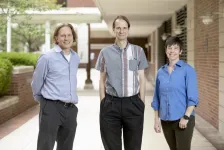Poor use of science jeopardizes climate lawsuits -- Oxford research
2021-06-28
(Press-News.org) Newly-available scientific evidence, which could prove critical to the success of climate-related lawsuits, is often not produced in court, according to a new study published today by the Oxford Sustainable Law Programme and Environmental Change Institute.
Filling the evidentiary gap in climate litigation in Nature Climate Change, a leading interdisciplinary science journal, is the first global study on the use and interpretation of climate-science evidence in lawsuits.
The study reveals evidence submitted by litigants in 73 lawsuits across 14 jurisdictions is significantly behind state-of-the-art climate science, impeding claims that greenhouse-gas emissions have caused the impacts suffered by plaintiffs.
In most cases there was no attempt to quantify the extent to which climate change was responsible for the climate-related events causing the impacts affecting plaintiffs - an important line of evidence since not all events occur due to climate change.
Even fewer cases provided quantitative evidence linking defendants' emissions with the plaintiffs' injuries. Some 73% did not refer to peer-reviewed evidence. And 48% of the cases that focused on extreme weather events claimed that the weather occurred due to climate change, without providing evidence.
From 1986 until May 2020, plaintiffs globally have brought more than 1,500 climate-related lawsuits, with the rate of claims increasing. High-profile cases, such as Native Village of Kivalina v. ExxonMobil Corp, which was dismissed at the US Court of Appeals, have shown that strong evidence of causation is critical to successful litigation.
The study makes clear that cutting-edge, peer-reviewed attribution would allow lawyers to ascertain the prospects of successful litigation before cases reach court.
Lead author, Rupert Stuart-Smith, says, 'In recent weeks, successful lawsuits in the Netherlands, Germany, and elsewhere have seen courts demand countries and companies dramatically strengthen their climate targets. The power of climate litigation is increasingly clear.
'However, many climate-related lawsuits that rely on evidence on the link between greenhouse gas emissions and climate change impacts have been unsuccessful. If litigation seeking compensation for losses suffered due to climate change is to have the best chance of success, lawyers must make more effective use of scientific evidence. Climate science can answer questions raised by the courts in past cases and overcome hurdles to the success of these lawsuits.'
The study authors call for greater awareness and use of attribution science when bringing climate litigation, 'Effective use of climate-science evidence in the courts could overcome existing obstacles to causality, set legal precedent for demonstrating causality with climate-science evidence, and make successful litigation on climate-change impacts feasible.'
Attribution science has recently been used to prove the impact of man-made climate change on extreme weather events such as Hurricane Harvey.
As well as providing better evidence, attribution science can inform the decision to pursue climate litigation cases, with uncertainties around some types of events (like droughts) being much higher than others (e.g. large scale extreme rainfall).
Dr Friederike Otto, Associate Director of Oxford's Environmental Change Institute, says, 'In order to change the fate of the vast majority of climate litigation cases, courts and plaintiffs alike have to realise that science has moved on from ascertaining that climate change is potentially dangerous to providing causal evidence linking emissions to concrete damages.'
Professor Thom Wetzer, Founding Director of the Oxford Sustainable Law Programme, says, 'Holding high-emission companies accountable for their contribution to climate change is key to driving systemic change and to protecting those most vulnerable to climate change impacts. Climate litigation aimed at generating that accountability is on the rise, but the results have been mixed.
'Our research provides reason for optimism: with rigorous use of scientific evidence, litigators have room to be more effective than they currently are. It is now up to litigators to translate state-of-the-art science into high-impact legal arguments.'
INFORMATION:
Notes for Editors
The Oxford Sustainable Law Programme
The Smith School of Enterprise and the Environment (SSEE) at the University of Oxford has recently established the Oxford Sustainable Law Programme (SLP) in close collaboration with the Faculty of Law and the Environmental Change Institute. This new multi-disciplinary research programme examines the use of the law in addressing the most pressing global sustainability challenges that humanity faces.
The Environmental Change Institute
The Environmental Change Institute at the University of Oxford was established in 1991 to organise and promote interdisciplinary research on the nature, causes and impact of environmental change and to contribute to the development of management strategies for coping with future environmental change.
True Planet: Oxford research for a changing world
The world is in a climate crisis, and Oxford researchers are at the forefront of trying to find solutions in adaptation and resilience, nature, energy transition, clean road transport and green finance.
Our researchers are working with partners in industry, government, the third sector and at other universities to address these challenges and to propose innovative approaches and solutions. Find out more about our True Planet campaign http://bit.ly/trueplanet
ELSE PRESS RELEASES FROM THIS DATE:
2021-06-28
(Boston)--Amyloid diseases, including Alzheimer's, Parkinson's, type-2 diabetes and other life-threatening diseases, involve pathologic deposits of normally soluble proteins or peptides as insoluble amyloid fibrils. When this happens in vital organs, such as the brain, kidney, liver and heart, it causes organ damage and, if left untreated, death. Unfortunately, the available treatment options are very limited.
Now a new study from researchers at Boston University School of Medicine (BUSM) improves our understanding of how heparan sulfate and related biopolymers such as heparin, which is perhaps best known as a blood thinner, can promote amyloid deposition in various organs.
The researchers ...
2021-06-28
(COLUMBUS, Ohio) - While little research exists on how and why the rates of Black youth suicide are rising, research does show the rate of suicide in Black youth younger than 13 years of age is approximately two times higher compared to white peers. From 2009 to 2019, the percentages of Black youth who considered suicide, made a suicide plan and attempted suicide all increased.
In a statement published in JAMA Pediatrics, researchers at the Nationwide Children's Hospital, the University of North Carolina at Chapel Hill and the nonprofit research institute RTI International ...
2021-06-28
What The Study Did: The rates, duration and dosages of opioids prescribed to children, adolescents and young adults from 2006 to 2018 were examined in this study.
Authors: Madeline H. Renny, M.D., of the New York University Grossman School of Medicine, is the corresponding author.
To access the embargoed study: Visit our For The Media website at this link https://media.jamanetwork.com/
(doi:10.1001/jamapediatrics.2021.1832)
Editor's Note: The article includes funding/support disclosures. Please see the article for additional information, including other authors, author contributions and affiliations, conflict of interest and financial disclosures, and funding and support.
INFORMATION:
Media advisory: ...
2021-06-28
What The Study Did: Researchers compared health care access and quality scores for the United States with high-income countries with universal health insurance coverage and compared scores among U.S. states with varying insurance coverage.
Authors: Marcia R. Weaver, Ph.D., of the University of Washington in Seattle, is the corresponding author.
To access the embargoed study: Visit our For The Media website at this link https://media.jamanetwork.com/
(doi:10.1001/jamanetworkopen.2021.14730)
Editor's Note: The article includes conflict of interest and funding/support disclosures. Please see the article for additional information, including other ...
2021-06-28
What The Study Did: High school students in Austria were surveyed about their well-being, sleep quality, eating and symptoms of depression and anxiety during the COVID-19 pandemic.
Authors: Christoph Pieh, M.D., of Danube University in Krems, Austria, is the corresponding author.
To access the embargoed study: Visit our For The Media website at this link https://media.jamanetwork.com/
(doi:10.1001/jamanetworkopen.2021.14866)
Editor's Note: The article includes conflict of interest and funding/support disclosures. Please see the article for additional information, including other authors, author contributions and affiliations, conflict of interest and financial disclosures, and funding and support.
INFORMATION:
Media advisory: The full study ...
2021-06-28
A gene variant that lowers white blood cell levels and is common in individuals with African ancestry contributes to unnecessary bone marrow biopsies, according to a study published June 28 in JAMA Internal Medicine.
The findings from three institutions, led by investigators at Vanderbilt University Medical Center, provide an example of how using genetic data could reduce a health disparity.
"We've essentially created this racial health disparity by not fully considering how genetic variation affects white blood cell levels," said Jonathan Mosley, MD, PhD, assistant professor of Medicine and Biomedical Informatics at VUMC. "Our study supports genotyping African Americans before ...
2021-06-28
Most people associate the term "wearable" with a fitness tracker, smartwatch, or wireless earbuds. But what if you could wear cutting-edge biotechnology in your clothing, and it could warn you when you were exposed to something dangerous?
A team of researchers from the Wyss Institute for Biologically Inspired Engineering at Harvard University and the Massachusetts Institute of Technology has found a way to embed synthetic biology reactions into fabrics, creating wearable biosensors that can be customized to detect pathogens and toxins and alert the wearer.
The team has integrated this technology into standard face masks to detect the presence of the SARS-CoV-2 virus in a patient's breath. The button-activated mask ...
2021-06-28
Researchers at Northwestern and George Washington (GW) universities have developed the first-ever transient pacemaker -- a wireless, battery-free, fully implantable pacing device that disappears after it's no longer needed.
The thin, flexible, lightweight device could be used in patients who need temporary pacing after cardiac surgery or while waiting for a permanent pacemaker. All components of the pacemaker are biocompatible and naturally absorb into the body's biofluids over the course of five to seven weeks, without needing surgical extraction.
The device wirelessly harvests energy from an external, remote antenna using near-field ...
2021-06-28
A worldwide team led by UC Santa Barbara scientists at Las Cumbres Observatory has discovered the first convincing evidence for a new type of stellar explosion -- an electron-capture supernova. While they have been theorized for 40 years, real-world examples have been elusive. They are thought to arise from the explosions of massive super-asymptotic giant branch (SAGB) stars, for which there has also been scant evidence. The discovery, published in Nature Astronomy, also sheds new light on the thousand-year mystery of the supernova from A.D. 1054 that was visible all over the world in the daytime, before eventually becoming the Crab Nebula.
Historically, supernovae have ...
2021-06-28
A worldwide team led by scientists at Las Cumbres Observatory has discovered the first convincing evidence for a new type of stellar explosion -- an electron-capture supernova. While they have been theorized for 40 years, real-world examples have been elusive. They are thought to arise from the explosions of massive super-asymptotic giant branch (SAGB) stars, for which there has also been scant evidence. The discovery also sheds new light on the thousand-year mystery of the supernova from A.D. 1054 that was seen all over the world in the daytime, before eventually becoming the Crab Nebula.
Historically, there have been two main supernova types. One is a thermonuclear supernova -- the explosion of a white dwarf star after it gains matter in a binary star system. These white ...
LAST 30 PRESS RELEASES:
[Press-News.org] Poor use of science jeopardizes climate lawsuits -- Oxford research


